Last Updated on July 1, 2024 by
Planning a Kochi itinerary and wondering about the things to do in Fort Kochi in one day? This Fort Kochi guide will cover all the amazing places to visit in Fort Kochi through a Walking Tour. Be ready to tick off your Kochi Bucketlist with this detailed Kochi travel guide covering streets in Fort Kochi, the architecture of Fort Kochi, cafes in Fort Kochi, and a lot more.
‘Welcome to the Queen of Arabian Sea, a melting pot of all cultures’ said Satish, my guide who picked us up from our hotel while heading to the Fort Kochi area. He informed us how Kochi is surrounded by backwaters and has many bridges to cross small islands. After a brief background about Kochi city, he told us the history of Fort Kochi and how it has embraced many religions and cultures throughout the many centuries.
I was on my third trip to Kochi but never explored the Kochi city or the Fort Kochi area as I used it only as a transit point for my road trip in Kerala. But I was excited to explore it this time.
Table of Contents
ABOUT FORT KOCHI
Fort Kochi is India’s historic port town with roots in the 14th century and influenced by a flow of European, Egyptian, Arab and Chinese merchants. Kochi was part of the silk and spice route for these traders.
Kochi is a mix of small islands and Fort Kochi and Mattancherry are the historic colonial areas within the city limits. Fort Kochi is primarily home to the Christians influenced by the European settlers. While Mattancherry is the vibrant trade centre and home to the Jews, Muslims and Hindus.
Due to the colonial influence, Fort Kochi has many heritage buildings that are over 500 years old. Not only buildings but many historical records, antiquities and even the mortal remains of important traders still find a place in Fort Kochi. Most of these are now part of the tourist circuit in Fort Kochi.
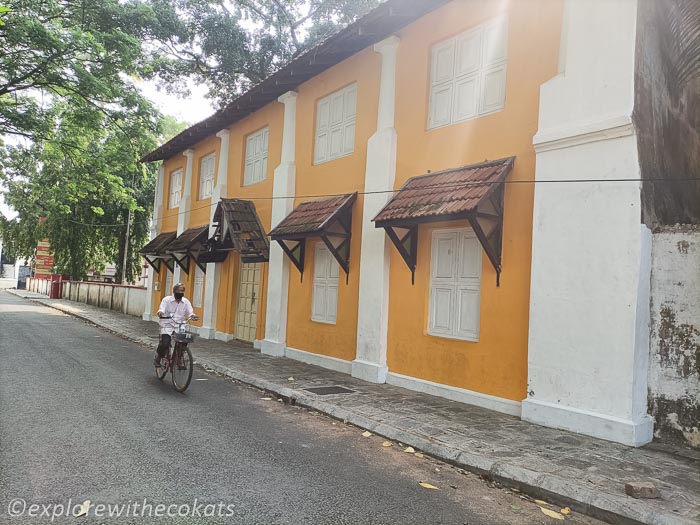
HISTORY OF FORT KOCHI
Fort Kochi was a fishing village in pre-colonial Kerala. The Portuguese arrived in 1498 during the Age of Discovery, and the Cochin king allowed the Portuguese to settle in the Fort Kochi area for 160 years.
The ‘Fort’ in Fort Kochi comes from Fort Emmanuel which was constructed to protect their commercial interests. However, the Dutch later destroyed it. The Dutch ruled Fort Kochi for 112 years.
It was later captured by Britishers who ruled the place for 152 years.
With such a diverse history of colonization, Fort Kochi is now a treasure trove for tourists.
BEST TIME TO VISIT FORT KOCHI
Kochi remains hot and humid all year round but winters (November to February) are by far the best time to visit Kochi as the weather is very pleasant. Summer in Cochin can get extremely hot and humid and temperatures begin to rise in March. I went in the first week of May and the outdoors were really uncomfortable.
If you want to see the Onam celebrations in Kochi, September is the time when the festival happens. The Snake boat race also takes place during the same time
HOW TO GET TO FORT KOCHI FROM KOCHI AIRPORT
Fort Kochi to Cochin International Airport is 30 km. It roughly takes 1.5 hours because of heavy traffic. Government bus service is available at a cheaper cost (INR 90) while app-based taxi and pre-paid taxi services are also available from the airport. Taxis charge anything between INR 1200 to INR 1800 one way from the airport.
Getting around Fort Kochi and Mattancherry
The best way to get around Fort Kochi and Mattancherry is by walking or by bike. Hire a local guide who can take you around Fort Kochi exploring the quaint neighbourhoods and heritage mansions.
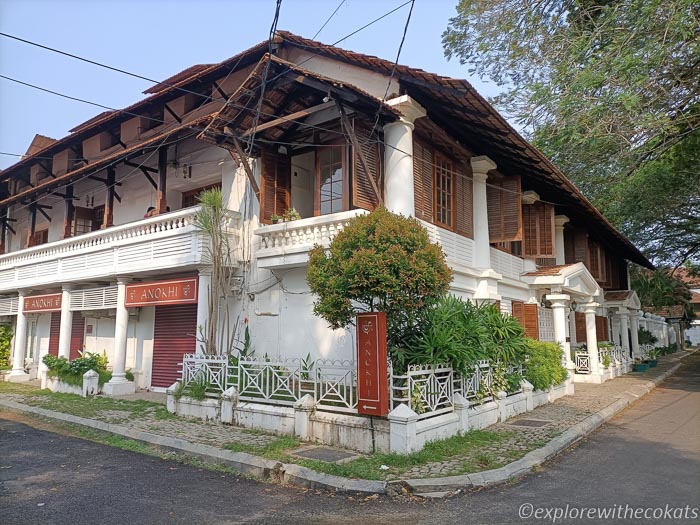
FORT KOCHI WALKING TOURS | FORT KOCHI HERITAGE WALK
The best way to explore any area, especially its heritage through a heritage walk. Heritage walks are synonymous with many cities in India and they are the best way to know a place in depth. Read about: Ahmedabad Heritage Walk.
One of the best ways to explore Fort Kochi is by the Fort Kochi walking tour, or bike tour. These are guided tours held by local guides or organizations and take tourists through the important yet offbeat places of Fort Kochi. The duration of the walking tour is 2-3 hours.
Fort Kochi Heritage walks with a unique itinerary:
Heritage walk
- Learn about the European settlement in Kerala by walking through street names such as Burger street, loafers corner, princess street and Lilly Street.
- Walking through old avenue trees that are dated more than 500 years. One of them is assumed to be the world’s biggest Christmas tree.
- Photograph the colonial houses, each having a unique history. Most of these are converted into bungalows, heritage hotels, elite hotels, boutique hotels, and leftover English clubs.
- Explore the monuments of St. Francis Church and Santa Cruz basilica church.
- Finish the walk at Chinese fishing nets and the beach with some souvenir shopping.
Urban spice trail walk
- Know about the rich heritage cultural colonies exploring the spices that are grown in each house.
- Pay a visit to the world’s biggest Christmas tree called the rain tree.
- Visiting the Dhobi Khana, a community introduced by the Dutch and British who are involved in laundry services.
- Pay respects to the 34 multilinguistic Hindu orthodox religious communities who live in harmony.
- Visiting a flour mill to see how it works.
- Walk to the biggest Kerala Tirumala temple of Asia’s biggest working bell.
Other Fort Kochi walking tours are Christian Heritage Walk, Kochi Food Tours and many others.
Since we had about 4 hours in hand, we combined the best of these 2 itineraries and explored all that we could in Fort Kochi and Mattancherry.
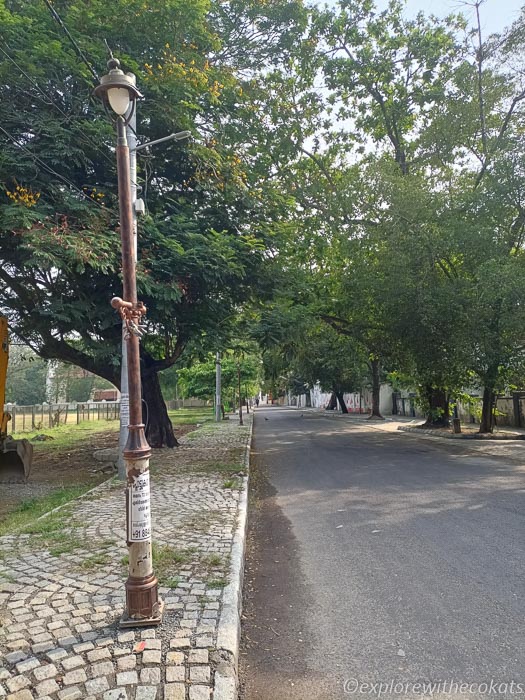
BEST THINGS TO DO IN FORT KOCHI
We parked somewhere near the Dutch cemetery and started our walk through the shaded pathways of the Dutch colony. The following sums up my experience and all the things to do in Fort Kochi in one day.
Walk along the Dutch Colony road
Get friendly with the peaceful and clean roads with cobbled pavements, antique-looking street lights and heritage mansions. Just soak in the architecture of how these colonial mansions have now turned into boutique shops, airbnbs and even government offices.
Pay homage to the Dutch Cemetary
The tombstones here are the most authentic record of the hundreds of Dutch people who left their homeland in a mission to expand their colonial empires and who changed the course of the history of the land they conquered. The cemetery was consecrated in 1724 and is now managed by the Church of South India.
The gate to the Cemetary is generally closed but visitors can peek in through the gate and notice the Portuguese inscriptions on the tombstones.
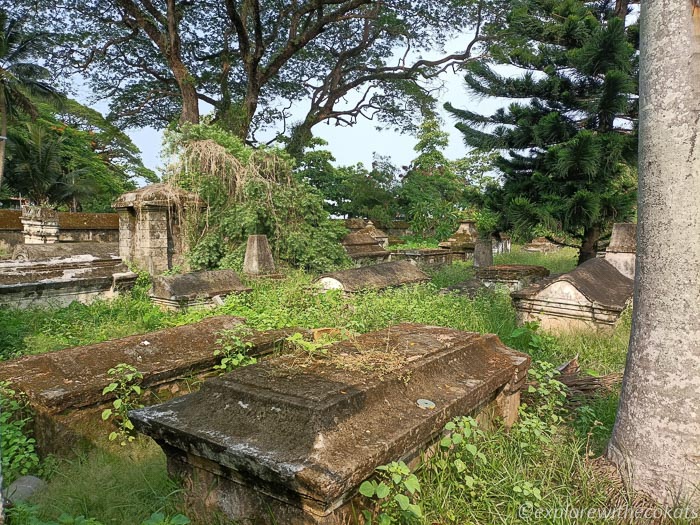
Visit the Vasco House Fort Kochi
Believed to have been the residence of Vasco da Gama, Vasco House is one of the oldest Portuguese residences in Fort Kochi. It is now a private residence and offers a heritage home stay facility.
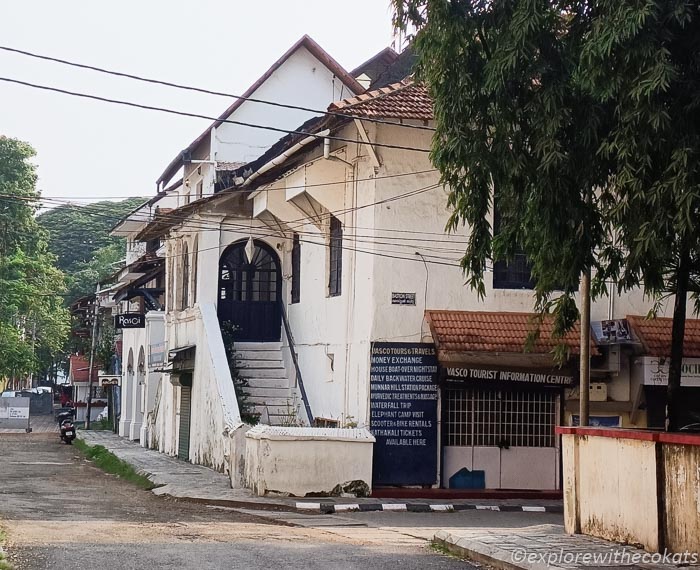
Visit the St. Francis Church Cochin
Built in 1503 by the Portuguese, this is believed to be India’s oldest European church. The church was initially built of wood and was a rather humble-looking church following Roman Catholic preachings.
It was captured by the Dutch and then the Britishers. It was later reconstructed in stone.
The church has always been important as the explorer Vasco da Gama was buried here in 1524. His mortal remains were later moved to Lisbon, Portugal. But his tomb was taken inside the church during renovation. This makes the visit to St. Francis Church is one of the most historical things to do in Fort Kochi.
This humble church is one of the best tourist attractions in Kochi. It is still an active church wherein over 250 families take part in the Sunday mass.
One of the most striking features of the church is the manual fan that is hung from rods on either side of the room. In the olden times without electricity, people stood on the side of the rod’s end and pulled ropes to make the fabric swing and generate a breeze. One of the specialities of these fabric swings was they used to be stuffed with herbal roots. The fabric was then sprinkled with water. On swinging this fabric laden with herbs and water, is used to provide cool relief during hot and humid months.
The church has Victorian tiles in the centre of the church from the British era. The church still has instruments (mouth organ, piano, wooden pulpit, reading desk) from the bygone era and the same are being used and played during the Sunday mass.
St. Francis Church Timings: 9:00 am – 5:00 pm (Monday – Friday), 9:00 am – 1:00 pm on Saturday, and 1:00 pm – 5:00 pm on Sundays.
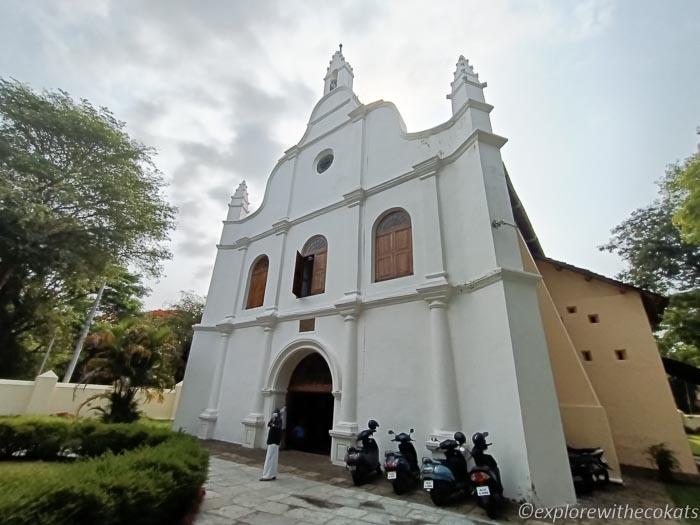
Visit Bastion Bungalow
Head to the 17th-century Indo-European architecture mansion called Bastian Bungalow. It was used as a residential building during the British period. At present, it is used as the residence of the Sub-Collector of Kochi. The Bungalow on top of the Bastion is in European style with large rooms and high roof ceilings.
It is a protected monument and a heritage museum with a large collection of artefacts.
Bastion Bungalow Timings: Open all days from 10:00 am – 5:00 pm (Lunch break 1:00 pm – 2:00 pm).
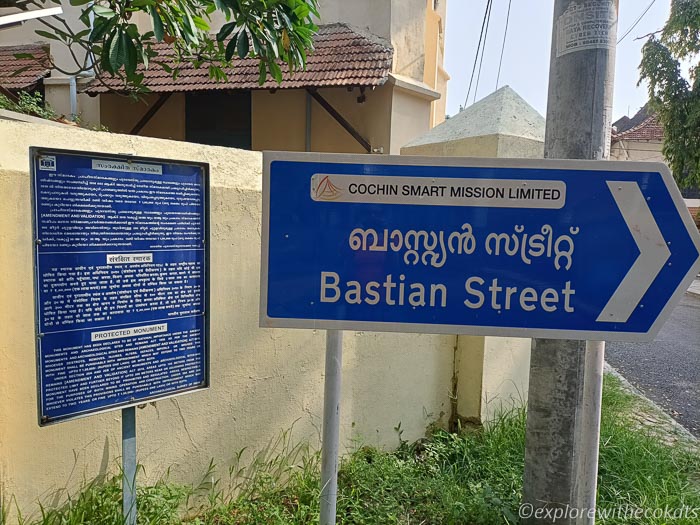
Explore Vasco Da Gama square
Head to the square which is always active with many things to do in Fort Kochi. The steam boilers exhibit is hard to miss as soon as one enters here. Steam Boilers from a dredger are installed near the walkway at Fort Kochi beach.
The square is also popular for souvenir shopping in Fort Kochi with street vendors selling street food, souvenirs and ice creams.
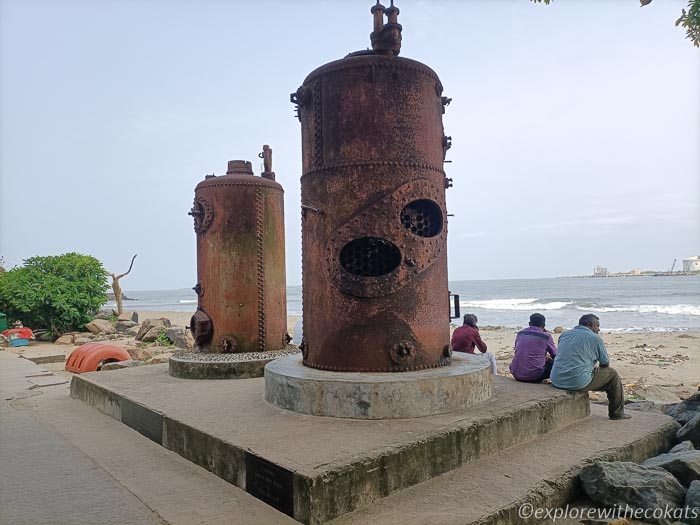
Dip feet at Fort Kochi beach
Overlooking the Vasco da Gama square in the Kochi Beach. A walkway leads to a promenade which is a good spot for photography.
Kochi overlooks the Chinese Fishing Nets and the ships that come and go. The beach also overlooks a factory which makes the beach not such a great place to hang out. The beach is also dirty which makes you think twice before dipping your feet in the water.
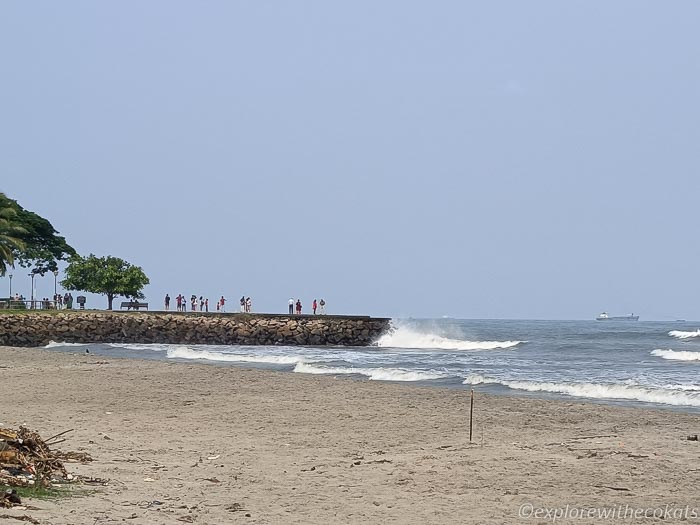
Chinese Fishing Nets, Fort Kochi
Locally known as ‘Cheenavala‘ and popularly known as Chinese Fishing Nets were introduced in the 14th Century by a Chinese explorer in Kochi. This method is said to be one of the oldest and most traditional fishing methods in the world. Visiting the Chinese Fishing nets is one of the Kochi Bucketlist places and most popular things to do in Fort Kochi.
Earlier the nets used to be smaller where one fisherman could manage the operation. However, now the entire Chinese fishing net assembly weighs over 250 kg and requires 4-5 men on deck for work. Fishing is usually done in the morning and early evening.
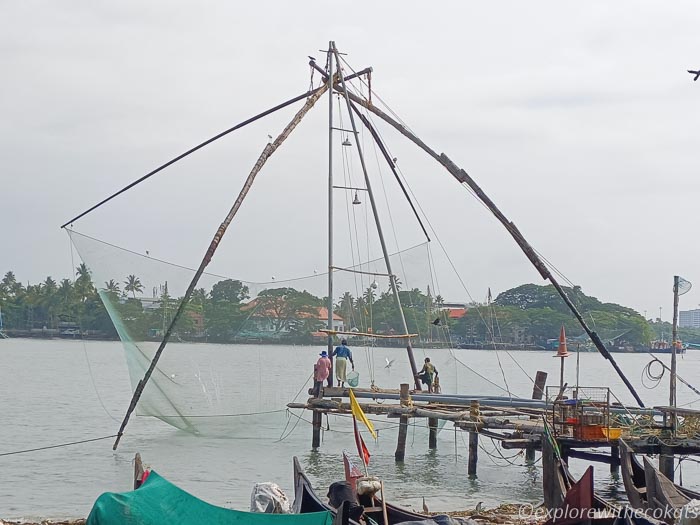
The structure is made of teak wood and bamboo poles, that are 10m high, fixed on the beach and has a cantilever with an attached net that is spread over an area of about 20 meters. Stones as counterweights are tied to ropes of different lengths that facilitate the working of the nets.
The net is descended into the water for a short time and then raised delicately by pulling on the ropes. The fish catch is collected by a sailed net, segregated and stored. The caught fish is sold in nearby markets by auction. Unwanted fishes that do not have any selling value are returned back to sea.
Only 8 Chinese Fishing Nets remain here in Fort Kochi and are part of the city’s Heritage.
Watching this procedure from distance is free but in case you want to walk on the planks and see the process up close, the fishermen charge money. Worth the Instagram shot? Absolutely!
Check the working of Chinese Fishing Nets at Fort Kochi in this Instagram reel.
Kerala Kathakali Centre
A trip to the Kerala Kathakali centre is highly recommended while in Fort Kochi. The centre showcases traditional dance – Kathakali and martial arts – Kalaripayattu every day.
Kalaripayattu is one of the oldest martial art forms in the world that originated in Kerala in the 3rd century. Considered among the oldest and most scientific martial arts in the world, the word ‘Kalari’ literally means ‘battlefield’ and ‘payattu’ means ‘training of martial arts. Kalaripayattu uses weapons such as swords and daggers, sticks, spears, maces, axes arrows, discuses, catapults, boomerangs and others.
Kathakali is a form of classical Indian dance. It is unique as it is distinguished by the elaborately colourful make-up, costumes and facemasks that the traditionally male actor-dancers wear. The dance form is associated with storytelling through dance.
Tickets can be bought on the Centre’s premises ahead of the performance. Ticket price: INR 300 per person and duration is one hour.
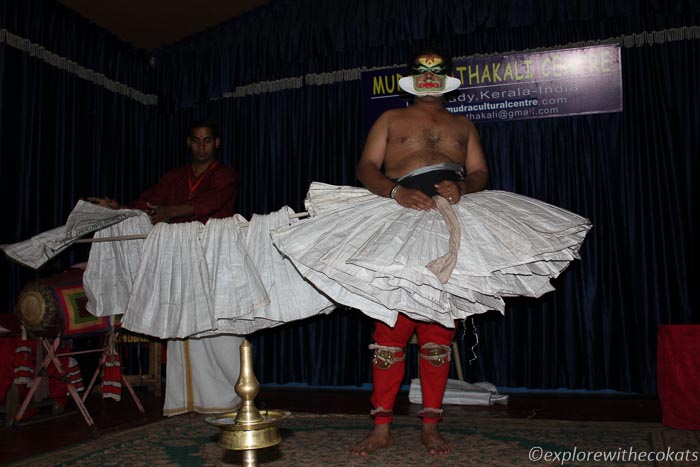
Visit Santa Cruz Cathedral Basilica, Fort Kochi
Santa Cruz Cathedral Basilica is one of the most beautiful places to visit in Fort Kochi. Built in 1558 by the Portuguese, it was later destroyed by the Britishers in the 19th century. On the same ground, a bishop rebuilt the cathedral and it was proclaimed a Basilica in the early 20th century.
The stained glass in the interior, the gothic architecture and the wall murals definitely give a European vibe. It surely reminded me of St. Mary’s Basilica in Krakow, Poland.
Santa Cruz Cathedral timings: (Monday to Saturday) 9:00 am – 1:00 pm and 2:30 pm – 5:30 pm, Sunday: 10:30 am – 1:00 pm. It is closed on the first Friday of every month.
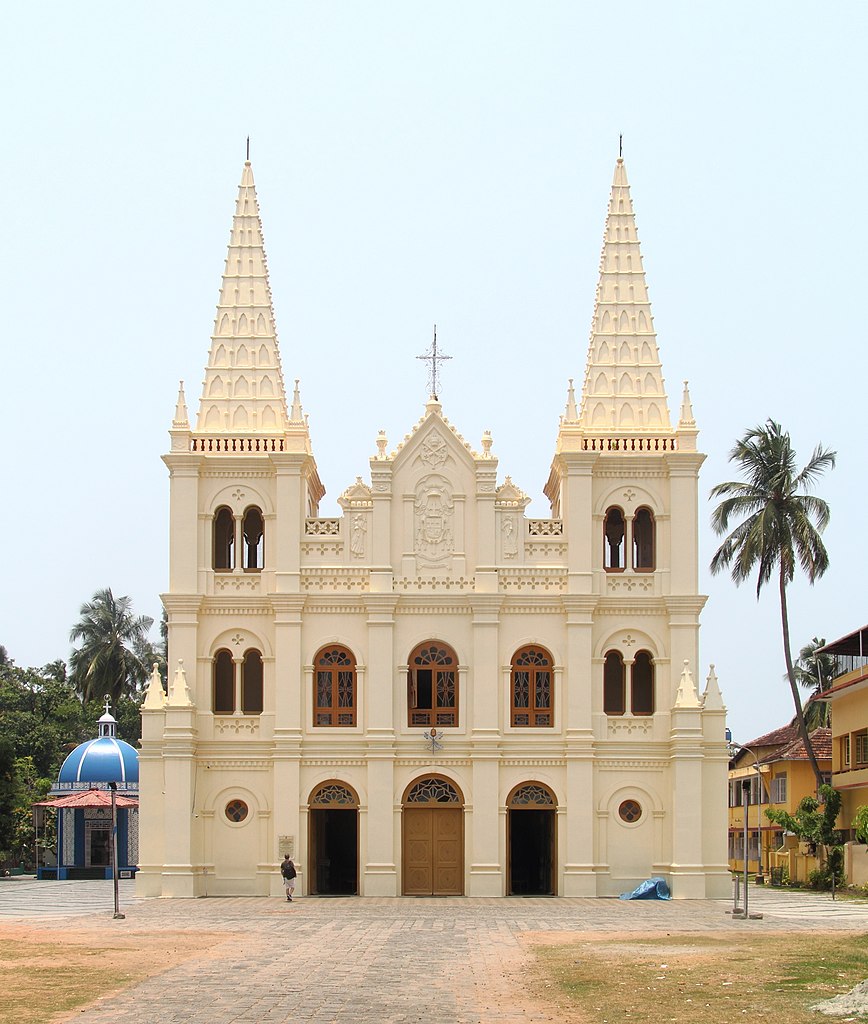
Praise the Fort Kochi Street Art
With many art galleries to boast of in Fort Kochi and Mattancherry, visitors can get a flavour of art on the streets too. Everywhere around Vasco da Gama square and Mattancherry, visitors cannot miss the wall art on walls. Burger Street is also a lane full of colourful corners and walls. The street art is done by local and international artists. Portraits, murals, and graffiti in different shapes, sizes and colours adorn the walls.
This street art is done every year during the Muziris Biennale – A contemporary art event where art sessions, art exhibitions, talks, workshops, educational performances, film screenings etc are held. Happening worldwide, Kochi is also a host of this festival.
Because of the pandemic, Muziris Biennale was not held for 2 years which has made the murals fade away in most areas. Kochi-Muziris Biennale is set to open on December 12, 2022, and will run for four months, till April 10, 2023.
Must visit art galleries in Fort Kochi are Durbar Hall Art Gallery, David Hall and OED Art Gallery.
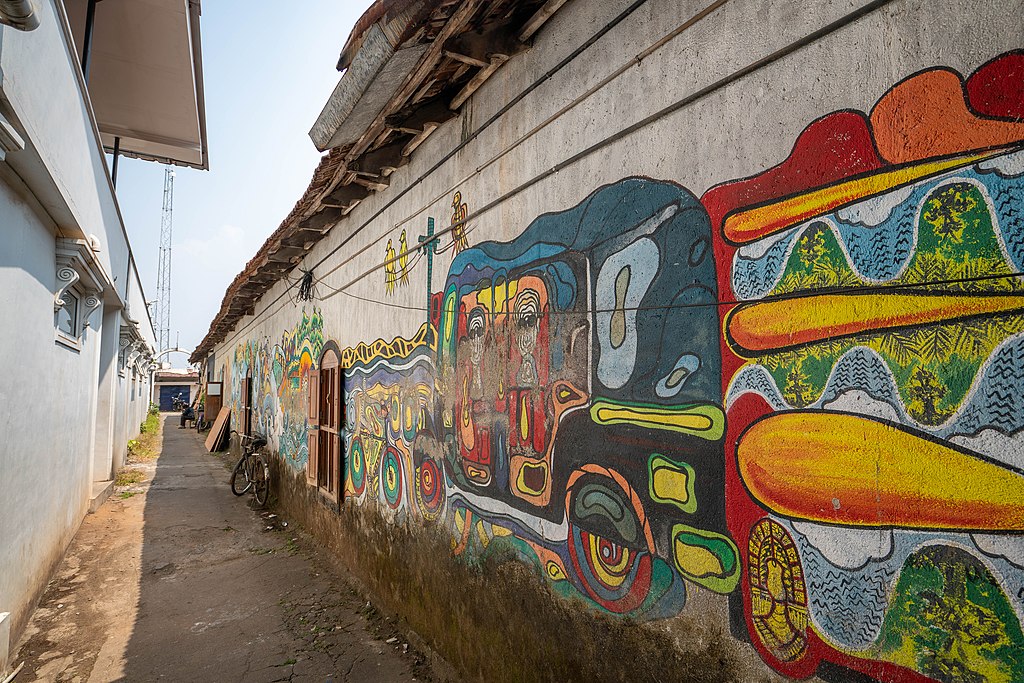
Getting Ayurvedic Treatments in Fort Kochi
Kerala is home to the ancient tradition of Ayurveda. While Thekkady is a more popular place for getting these treatments, Fort Kochi also offers Ayurvedic massages for tourists who are not travelling elsewhere.
Ayurville is one of the most recommended places in Fort Kochi for getting Ayurvedic treatment. It offers long-duration retreats with stay and food for holistic healing. The treatment solutions are for people suffering from chronic ailments.
Cafe Hopping at Fort Kochi
There is a strong coffee and art culture in Fort Kochi and if you are visiting here, then cafe hopping in Fort Kochi is one of the best things to do in Fort Kochi. There are many coffee shops and cafes dotted around Fort Kochi and it can truly be challenging to choose one to visit during a Kochi day trip.
Kashi Art Café
Kashi Art Café is the most popular café in Fort Kochi and was recommended by at least 4 people to visit.
I visited it in the morning around 10:30 am and it was already full with locals and tourists grabbing some breakfast overlooking some unique installations. The cafe has a relaxing ambience and is full of green vibes. There are shrubs and creepers everywhere as well as some contemporary artwork displayed at the entrance.
I tried the ginger lemon soda as I was full not looking for food, and it was decent. The food looked appetizing and I promised myself to come back here during a more relaxed time.
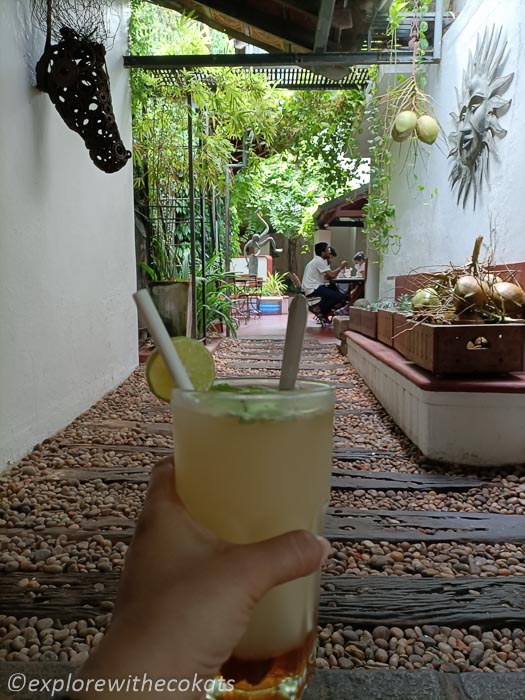
Brunton Boatyard
The colonial-style building right by the harbour is hard to miss. With splendid views of the waterways and this cafe is the perfect place to enjoy a sundowner.
Fort House Hotel
Fort House Hotel serves authentic Keralan cuisine at its waterfront restaurant. This family-run hotel provides panoramic views from the table. Some of the must-try here is Ginger-garlic prawns with appams and fish with green mango curry.
The Jetty Restaurant at the Forte Kochi Hotel
Located in the Heritage property on Princess Street, Forte Kochi Hotell is a beautiful plan to stay, visit and dine. Jetty Restaurant is a poolside restaurant that serves delicious vegetarian and non-vegetarian varieties of Indian and International cuisines.
Ginger House & Hotel
A perfect lunch spot is Ginger House after all the walking and shopping for antique gift articles in Jew Town. this is a waterfront restaurant that is extremely green, vibrant and very different from what you may see.
Built in a typical colonial style with ornate woodwork and glass-paned windows it is a must-visit place in Kochi.
It is an open-air restaurant overlooking the Kochi waterways, has a huge garden and is decorated with antique art and crafts all across.
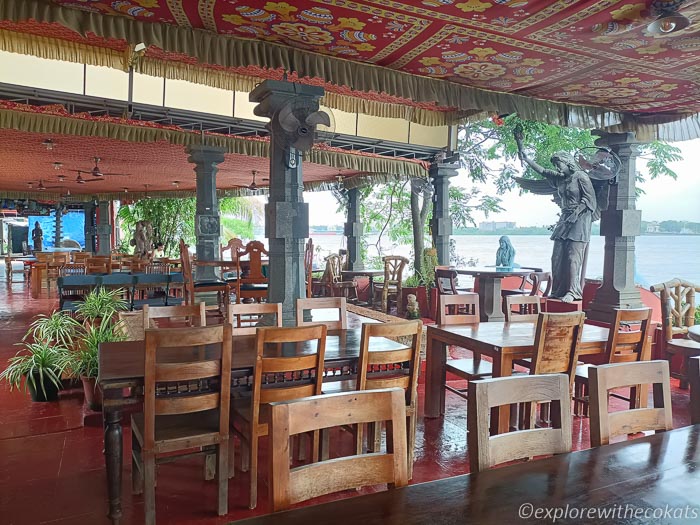
BEST THINGS TO DO NEAR FORT KOCHI – MATTANCHERRY AND JEW TOWN
While Fort Kochi always hogs the limelight, its neighbouring areas are nothing but a treasure trove and a must-visit in Kochi. A short ride away from Fort Kochi is Mattancherry and Jew Town, both tourist interest places offering unique places to see in Kochi.
Take a walk on the Palace Road
On the way to Mattancherry Palace, stop near the bustling streets to interact with the locals or simply observe them going about their lives. One can still find a number of traders selling spices as well as various religious places here: Temples, churches and mosques.
On the walk, we saw many fruit vendors and grocery stores selling unique items that are very particular to Kerala. Puja items and flower garlands for hair were also on display at many places.
We also visited a spice flour factory and a house making rice papads.
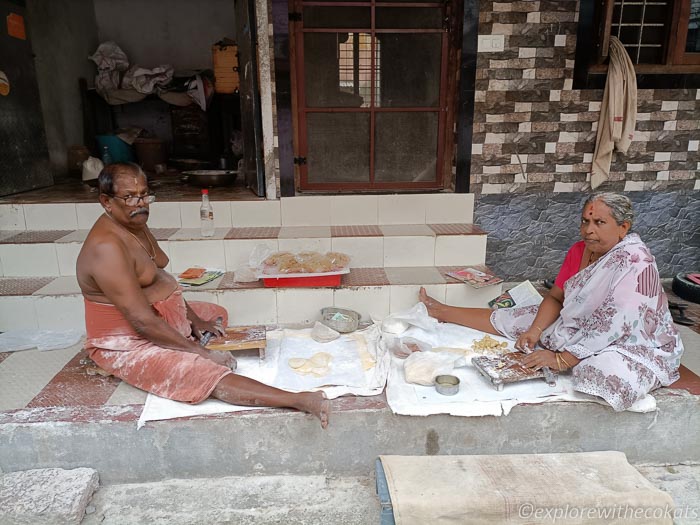
Pay respect at Cochin Thirumala Devaswom
Chochin Thirumala Devaswom is a temple with Sri Venkateswara as the main presiding deity.
The temple is a must-visit for its architecture. The double-storied northern tower or Gopuram is done in Pagoda style that is influenced by the Indo-Tibetian architecture. It has a copper-plated roof and wooden carvings depicting the scenes from holy relics.
Another important feature of the temple is its bronze bell. Every Hindu temple is known to have a bell or sometimes even multiple bells. However, Cochin Thirumala Devaswom has the largest bell in Asia in front of the main hall of the temple. The southern end before the main hall is richly decorated with chandeliers, domes and wooden sculptures. The exquisite carvings on inner ceilings depict scenes from Ramayana, Mahabharat and Bhagvat.
Note: Only Hindu worshippers are allowed inside the temple. Worshippers have to strictly adhere to the traditional dressing while entering the temple – women have to wear a saree and men in dhoti.
Visit the Mattancherry Palace Museum
If you think you are visiting a Palace like the ones in Udaipur or Jaipur then you will be disappointed.
Mattancherry Palace Museum is a humble-looking 2-storey plan building overlooking a pond lined by coconut trees.
Mattancherry Palace Museum is one of the oldest buildings of the Portuguese architectural style. Built in the 16th century, it was gifted to Bira Kerala Varma as an apology for plundering a temple nearby. It was accepted by the king and served as a set of the Royal House and hence was called a palace.
The palace underwent a major renovation in the later part of the 16th century at the hands of the Dutch and hence is also known as the ‘Dutch Palace’.
The palace is a perfect blend of Indo-European architecture. It palace museum consists of a coronation hall, bed chambers, lades chamber, royal dining hall and other rooms. The highlight of the palace lies in its wooden ceilings, murals and paintings covering over 300 square meters of area. The murals depict scenes from the Ramayana, Mahabharat, and legends connected to Indian gods like Vishnu, Krishna and Durga.
The museum also exhibits oil portraits of the Kings of Cochin their palanquins, dresses, weapons, coins and weapons.
Mattancherry Palace Museum timings: Open all days from 10:00 am – 5:00 pm except Fridays.
Mattancherry Palace Museum fees: INR 5
Note: Photography is not allowed in the rooms having murals.
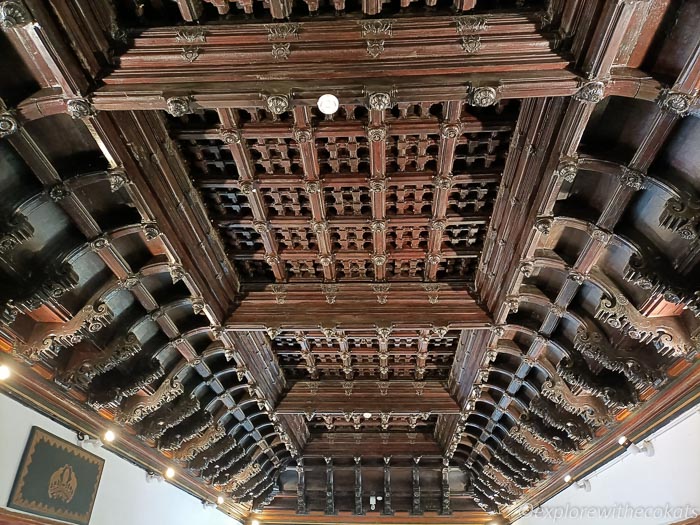
Shop for Vintage collectables
After coming out of the Mattancherry Palace Museum, our guide made us take a shortcut and we reached the backyard of scraps.
On going further these scraps took shape in the form of antiques. This is when we realised we were in the antique market in Jew Town.
Jew Town in Kochi is the biggest antique market in India. Each shop is divided into sections and sub-sections and honestly, it is like a maze where you keep going moving without finding an exit. It is very easy to get lost in the antique market of Jew Town so best to move around with a guide.
The antique shops here have a rich collection of antiques, crafts and spices in heritage buildings. Shops that look and feel as old as time are filled to the brim with antiques, that are beautifully cared for and displayed. Some of the most pristine and historically relevant artefacts can are found here. They are like fractions of history, waiting for the right person to come and finally claim them.
Shops towering over 2 storeys high with a basement are nothing short of a treasure waiting to be explored.
Photography is prohibited here. But some may allow you if you are with a guide.
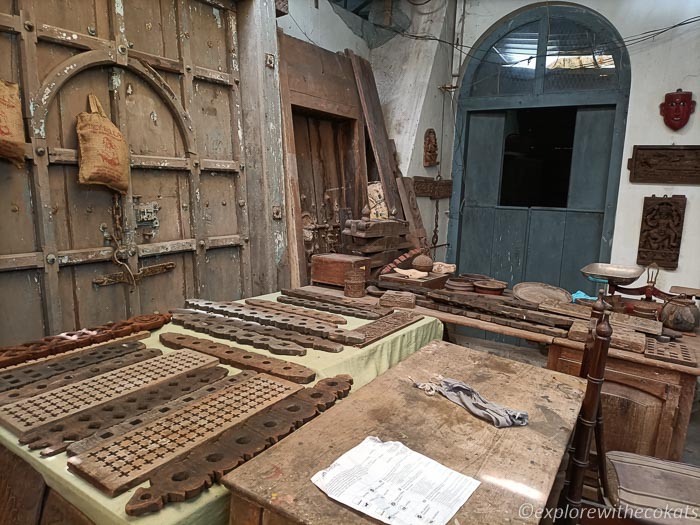
Visit the World’s longest canoe boat
Canoe boats are special for Kerala as they participate in Vallam kali, the traditional boat race in Kerala that is held every year during the season of the harvest festival Onam. This sporting event – Vallam Kali also known as Kerala Snake Boat Race is a huge attraction in Kerala and sporting enthusiasts visit the race from near and far. Each canoe boat is about 100 feet long and has a seating capacity of 150 men. Each boat is meticulously crafted by skilled craftsmen using local teak wood.
A 107-year-old wooden canoe boat is on display in one of the most humble-looking shops in the labyrinth lanes of Jew Town. It is no less than an art and one can praise the fine craftsmanship of making this snake boat which was once a pride of backwaters.
It is displayed at a shop 2 doors away from the entrance of Ginger House and Hotel.
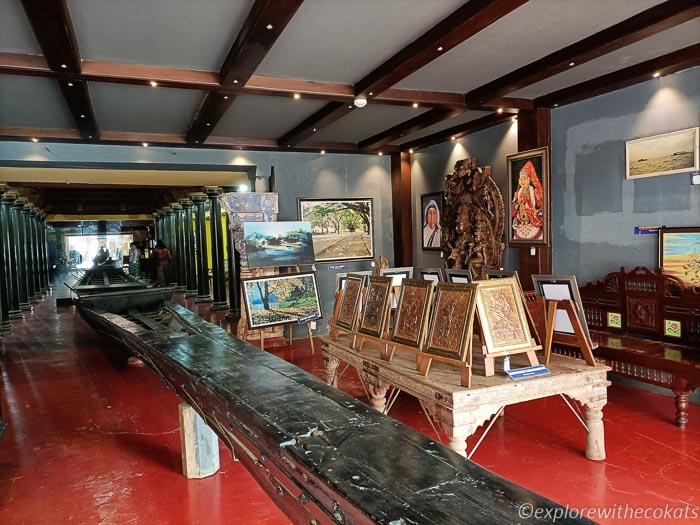
Visit the world’s largest cooking vessel ‘Varpu’
Another gem often missed by tourists in Jew Town is the display of the world’s largest ‘Varpu’. Varpu or Uruli can be translated to a cooking vessel. This huge cooking vessel is made of bronze, has a 12 feet diameter and weighs 3184 kilograms. Made in 2004 by the lost wax method by the craftsman in Munnar, it took 13 months for 30 craftsmen and 160 artisans to make it.
The vessel was crafted in a 14 feet trench and the mould was fired for 30 hours continuously.
It is displayed at a store called ‘Crafters’.
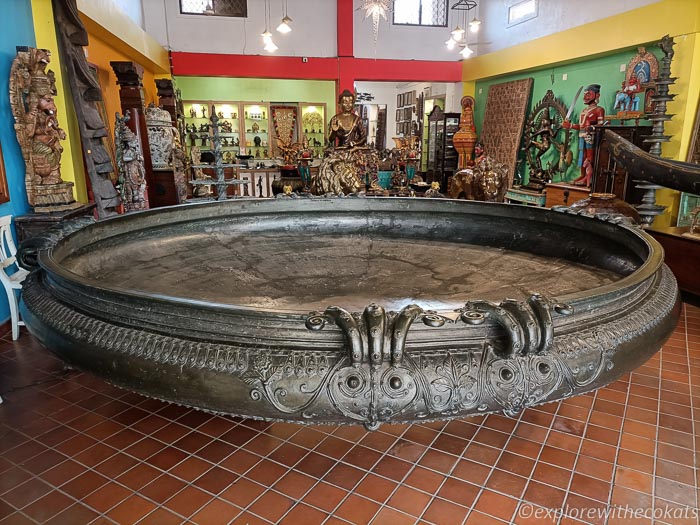
Try Aromatherapy in Jew town
Incense sticks, perfumes and attars all made from endemic flowers are found in shops around Jew town. Take a seat as the experts demonstrate various aromas and fragrances by placing a small drop of oil on your hand. Rub it and try to guess which flower is responsible for it. A small apparatus displayed at the shop gives the idea of how oils are removed from flowers
The oils removed from the flowers are used as base fragrances in many designer perfumes and body mists.
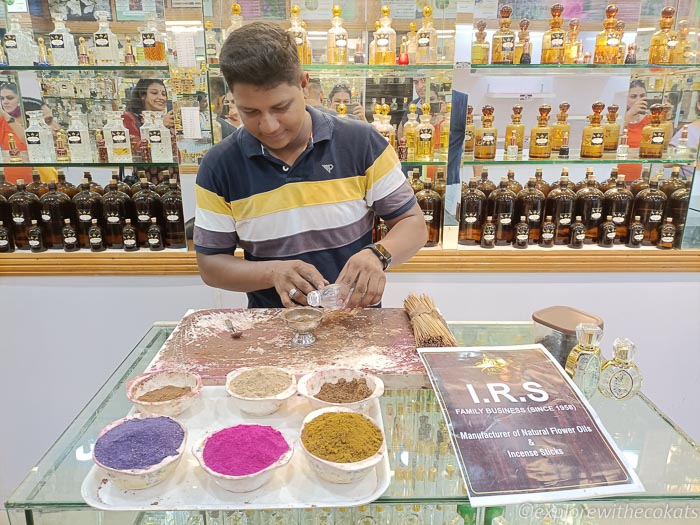
Walk the quaint streets of Jew Town
Jew town as the name suggests was a neighbourhood where Jews lived. Only 2 families live here now. But the colourful streets and vibrant shops are a must-visit place in Kochi.
Jew Town is actually a narrow shopping that leads up to the Jewish synagogue, Kochi. There are shops and art galleries on both sides of the street selling antiques, relics, Kerala souvenirs, handicrafts and clothes. It is a walking street with no motor activity allowed and is painted as though a street straight from the European markets.
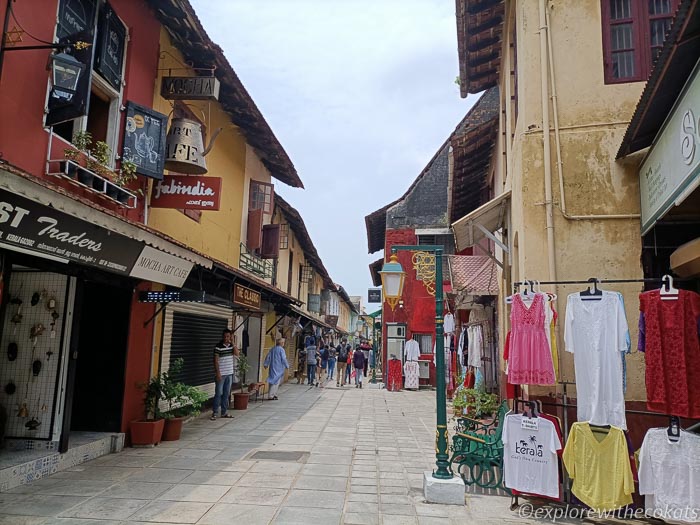
Spice shopping on Bazaar Road in Mattancherry
Coming to Kerala and not shopping for spices is a crime! Kerala is known for its spices that are grown all over the state. Green cardamom, cloves, pepper, cinnamon and nutmeg are some of the must-buy spices in Kerala. They are known for good quality and are adulteration free.
Explore the Paradesi Synagogue, Kochi
Walk to the end of the Jew street to reach Pardesi Synagogue. Pardesi means foreign and locals called the Jews “paradesis” or foreigners in the local language. That is how the Jewish Synagogue got its name Pardesi Synagogue.
This 16th-century synagogue was constructed after the Cochin gave them land. Paradesi Synagogue is the oldest and the most active one in Kochi.
A blossomed pink Bougainville near the entrance is quite a spectacle and the guard at the entrance requests visitors to put their phone in switch-off mode or hide it away in the bag. Photography is not allowed in the synagogue.
Hand-painted porcelain tiles from China, Belgian chandeliers, and the brass-railed pulpit demonstrate the charm of the bygone era. Spend some time in the sitting area just soaking in the interiors.
Pardesi synagogue timings: Sunday to Thursday – 10:00 am – 6:00 pm, and Friday 10:00 am – 2:00 pm. Pardesi Synagogue is closed on Saturday.
Pardesi synagogue entry ticket: INR 10 per person.
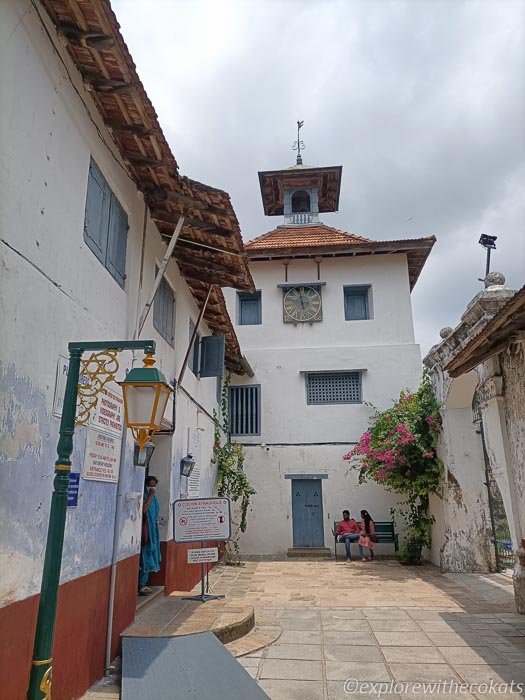
BEST HOTELS IN FORT KOCHI
If you going to be spending some time visiting the tourist spots in Fort Kochi then it is ideal that you book a hotel in Fort Kochi. Since most properties here are colonial mansions that are now converted into heritage villas and homes, it is the best way to spend time in Fort Kochi.
Heritage properties in Fort Kochi
Forte Kochi
One of the best-known heritage properties in Fort Kochi is the Brunton Boatyard. It is a CGH Earth property (CGH is a big name in luxury stays in South India) and is housed in a former shipyard from the British times. All of their rooms and en-suite bathrooms overlook the sea and you can catch some stunning sunsets dotted with silhouettes of Chinese fishing nets right from the comfort of your room. Do not forget to dine at their History restaurant where every dish has an interesting story behind it.
Forte Kochi can be booked here
Ginger House Museum and Hotel
I have already mentioned the art and restaurant of Ginger House Museum. But it is also a heritage property that offers a luxurious experience. It is popular amongst international tourists who are known to book the room’s furniture for their own home back home. Now that is a lovely USP to have.
Ginger House Museum and Hotel can be booked here
Dutch Bungalow, Fort Kochi
If you are looking for something less expensive, try the Dutch Bungalow. Built in 1668 by the Dutch, the mansion is more than 350 years old. The rooms have lofty ceilings, a separate living area, huge bathrooms, and a beautiful, rustic feel about them. I stayed here when visiting Fort Kochi and had an absolutely amazing time.
Dutch Bungalow can be booked here
Hostels in Fort Kochi
Mansions are the best way to stay in Fort Kochi, but if you are a backpacker then there are options for hostels as well. goStops and Zostel are one of the good chains of hostels and offer great value for money.
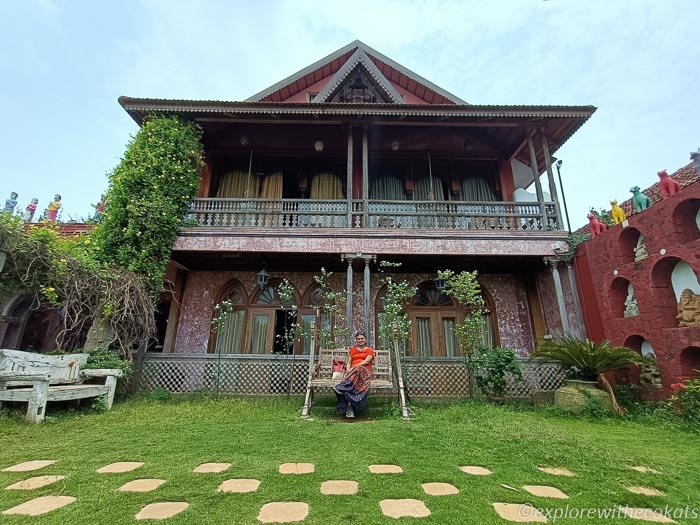
DAY TRIPS FROM FORT KOCHI
While Fort Kochi has a lot to do and explore, there are many day trips from Fort Kochi that are worth exploring. My favourite 3 places to visit for day trips from Fort Kochi are:
Cherai and Chendamangalam
Cherai is nestled at the northern end of Vypin island and is blessed with calm and shallow waters making it a favourite spot for swimming and bathing. It has a unique ecosystem having backwaters from the Arabian Sea on one side and Periyar River water on the other.
Apart from the beach, there are many water sports and adventure activities to choose from. There are many cultural and heritage sites in Cherai which makes it an interesting place to visit.
Among the places to visit near Cherai Beach, Chendamangalam Handlooms is also a cluster worth exploring. The Chendamangalam Heritage focuses on rural development and sustainability of the handloom industry. A guided tour here takes the visitors through the history, the process, and the ecological, and economic impact of Handlooms.
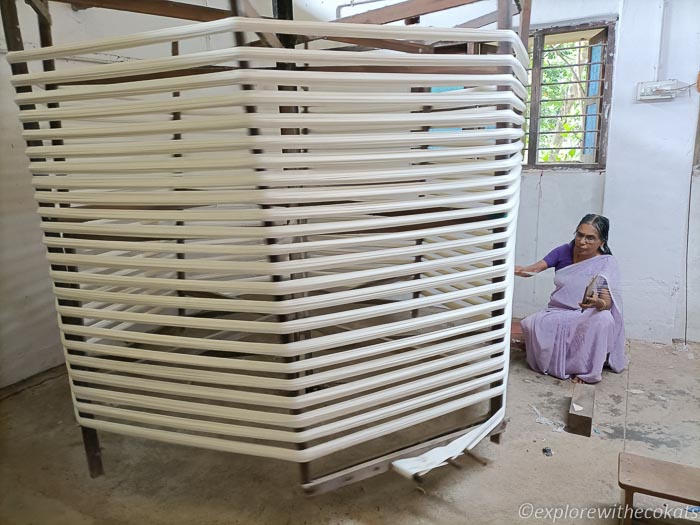
Alleppey
One of the most popular activities in Kerala is the houseboat experience in the backwaters of Kerala. Houseboats are available in Alleppey, Kumarakom and Kovalam. But the one on Alleppey has a different charm altogether.
Alleppey is around 50kms from Fort Kochi and takes you roughly 2 hours to get there by road. It is the ideal place to experience the houseboats of the backwaters.
Locally known as a Kettuvallam – the houseboat is primarily made of a wooden hull and thatched roof of coir. You can hire a houseboat for a day trip or spend a few days relaxing and sailing around the beautiful backwaters of Alleppey.
All houseboats are well-staffed including cooks who will prepare authentic Keralan cuisine. A standard menu includes fresh fish cooked in spices, steamed rice, curries with locally grown organic vegetables and fried banana fritters.
Read about my Alappuzha experience: Kerala Backwaters of Alleppey

Munnar
One day trip to Munnar is possible from Kochi and it is the perfect getaway to the hills. Munnar sightseeing includes visit to the tea garden, tea factory visit, boating and waterfalls.
If you have more time in hand, check out more posts on Munnar:
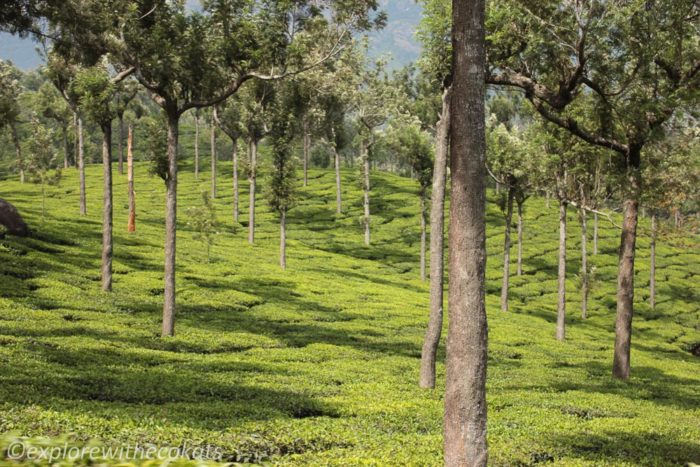
FORT KOCHI FAQ
Why is Fort Kochi called so?
Fort Kochi gets the name from Fort Emmanuel which the Portuguese first built when they landed in India.
Is Fort Kochi a fort?
Earlier there used to be a fort-like wall which gave it the name but only a stone remains around the Vasco da Gama store and can be easily missed unless local points it out. However, Fort Kochi has palaces, churches, mansions, beaches, areas of cultural importance, street art and food, that make it must visit.
Is Fort Kochi worth visiting?
Yes! Fort Kochi is a historical place have stunning mansions, beaches, areas of cultural importance, street art, food and other important landmarks. Fort Kochi appeals to tourists of all kinds and ages.
Is a guided tour required in Fort Kochi?
I would certainly recommend you to get one day guide for Fort Kochi who can take you to all the places of interest. I highly recommend C Satish who is a local Kochi guide who has immense knowledge of Kochi (architecture, heritage culture, flora, food and the list goes on). Since he is based in Kochi, he is a great resource for Fort Kochi Walking Tour. C Satish can be reached at +91 9495690929
Is Fort Kochi safe?
Yes, Fort Kochi is safe for all travellers, even solo women travellers.
Is Fort Kochi and Kochi the same?
No, Fort Kochi and Kochi are not the same. Fort Kochi is a small area in Kochi city. Fort Kochi is the most popular area for tourism in Kochi because of its heritage angle to this place.
Is Fort Kochi and Mattancherry the same?
No, Fort Kochi and Mattancherry are not the same. They are two different heritage neighbourhoods in Kochi and offer different places to visit. In Fort Kochi, there are mansions, ancient churches, street art, a beach and artsy cafes whereas in Mattancherry there is street shopping, an antique market, Paradesi Synagogue and a spice bazaar.
How much time do you need in Fort Kochi?
Fort Kochi is a small neighbourhood but has a lot to offer. It can be explored in one day or sometimes even 3 days in Fort Kochi are not enough. The itinerary can be planned as per time availability.
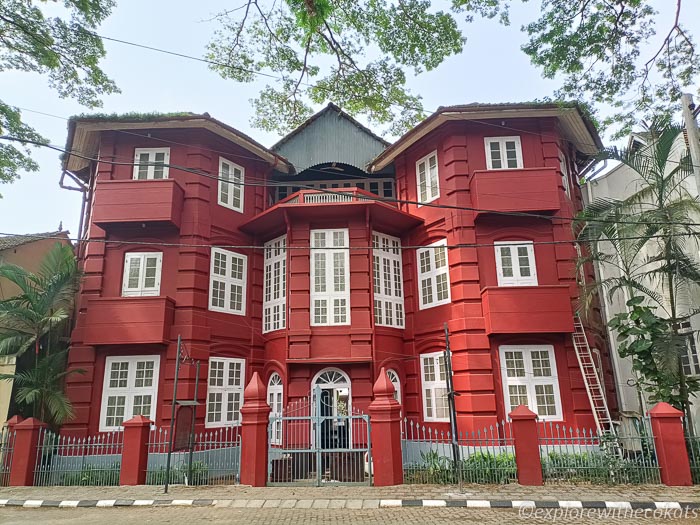
SUSTAINABLE TIPS FOR THINGS TO DO IN FORT KOCHI AND MATTNCHERRY
- Kochi is a unique city having cultural, heritage and environmental importance, so please respect it in all ways.
- Respect the ancient structures of palaces, synagogues and temples by not sitting on them or by carving or writing on it.
- Dress modestly in places of religious importance.
- Do not use phones or conduct photography where it is prohibited.
- Do not litter any of the tourist areas.
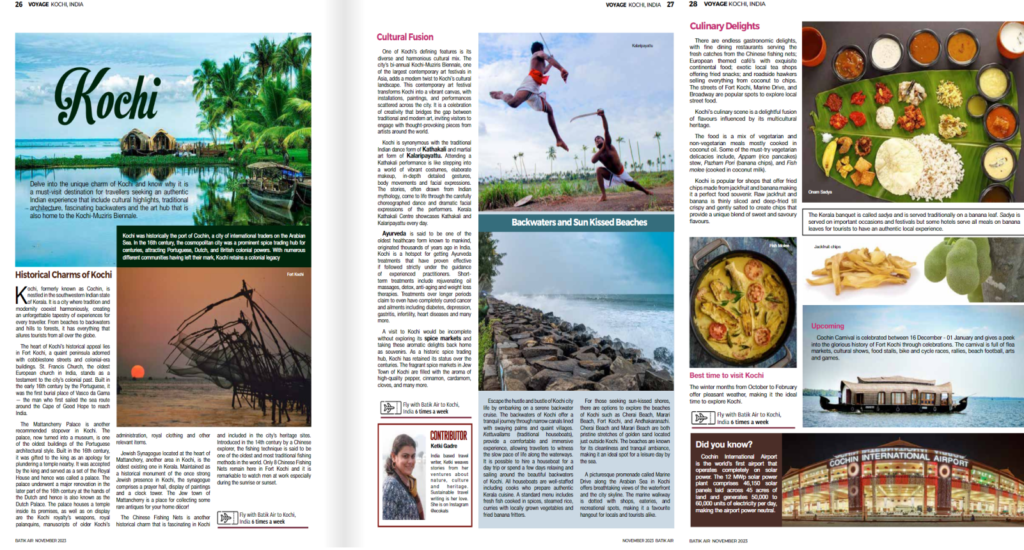
Overall experience of Things to do in Fort Kochi and Mattancherry in one day
Fort Kochi is special and I regretted not coming here on all my previous visits to Kerala. I also wished I had more time to explore other Fort Kochi walking tours and try the umpteen cafes here. I thoroughly had a lovely time overlooking the Fort Kochi streets lined with blue and yellow buildings, terracotta roofs and cobbled pavements reflecting the colonial era, and the modern art vibes. All these make Fort Kochi one of the most popular holiday destinations in India.
Read More Kerala posts:
- Kerala Backwaters of Alleppey
- Human by Nature: Impressions from Kerala
- Places to visit in Thekkady
- Eravikulam National Park
- Periyar National Park
- Things to do in Munnar
- Glamping in Munnar
- Chendamangalam Handlooms
- Responsible Tourism in Kumarakom
- Trekking in Munnar
- Things to do in Thiruvananthapuram
Disclaimer – This post contains affiliate links. It means it adds no extra cost to you if you book through the link but I get a referral bonus which helps me earn a little to keep this website up and running.
Pin this post!
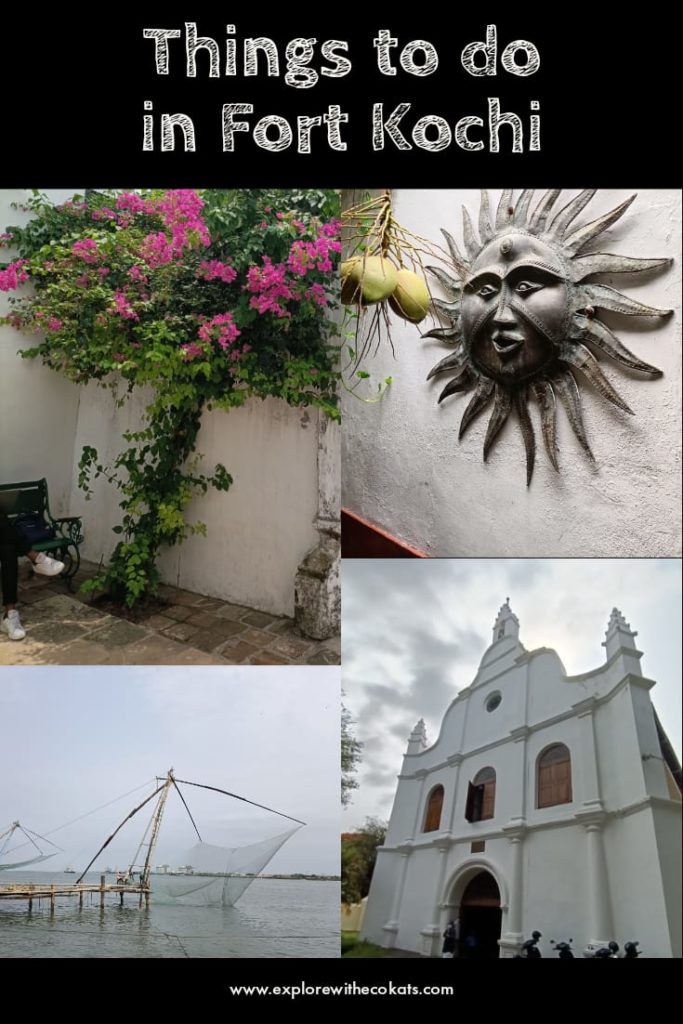

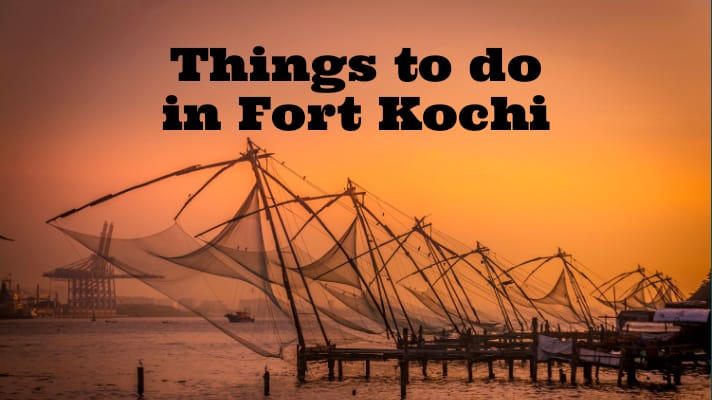
5 comments
Kochi has been on my list for so long! This is a great itinerary for art, culture, and history lovers and offers a peek into the local food as well.
I have been to Kochi a couple of times but never got the chance to explore the beautiful city. I always thought that Kochi is only a day of exploration. But, after reading your post, I would love to spend 2-3 days in the city itself.
[…] It is the perfect place to soak up some history and get some good shopping done. There are so many awesome things to do in Fort Kochi. Though, that’s if you can actually pull yourself away from the gorgeous […]
Thank you for giving this more information about Kochi and its places, I really liked it, I want visit the places as soon as possible, Thank you.
[…] it the Indian way – bargain with a fishman near the Chinese nets at Fort Kochi and pick your fish for a quick barbecue at one of the nearby […]